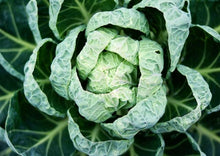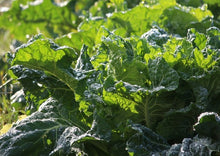Heirloom collards, also known as "Champion," are a type of non-hybrid, open-pollinated collard green variety. They are highly prized for their rich, flavorful leaves and hardiness in a variety of growing conditions. The origin of Heirloom Collards Champion can be traced back to the southern United States, where it has been a staple crop for generations.
The name "heirloom" refers to the fact that these collard varieties have been passed down through families and communities for many years, preserving the unique characteristics of the plant. This is in contrast to modern hybrid varieties, which are often developed for specific traits such as disease resistance or higher yields.
Heirloom collards are known for their distinctive, dark green leaves that are thick and tender. They can grow up to 2-3 feet tall and 2-3 feet wide, making them a great option for both small and large gardens. They are also very versatile, and can be eaten raw or cooked in a variety of dishes.
One of the unique characteristics of Heirloom Collards Champion is its ability to withstand cold temperatures, making it a great option for fall and winter gardening. They are also tolerant to heat and humidity, which makes them suitable for growing in the southern US.
Heirloom Collards Champion is also known for its high nutritional value. Collards are a good source of Vitamin K, Vitamin A, Vitamin C, Vitamin E, Vitamin B6, and Calcium. They are also high in antioxidants, which can help to protect against diseases.
Overall, Heirloom Collards Champion is a highly prized variety of collard green that is known for its rich flavor, hardiness, and versatility. Its origins in the southern United States have made it a staple crop for generations, and it continues to be a popular choice among gardeners and chefs today.
Champions produce plentiful greens from spring through late fall. Collards prefer cooler temperatures and thus make a good spring and fall crops. They become extremely sweet after a frost, and last in the garden unprotected beyond December. For a hearty cold season supply, start indoors in early July, transplant in August and let grow until first frost date. In a mild fall, they will continue to grow if harvested regularly.
Click here to download our free vegetable growing guide
Heirloom collards; Champion collards; Non-hybrid collards; Open-pollinated collards; Southern United States collards; Collard greens; Heirloom vegetables; Cold-tolerant collards; Nutritional value of collards; Antioxidant-rich collards; Collards for fall and winter gardening; Versatile collard dishes; Heirloom vegetable varieties; Collard greens for health; Popular collard green variety; Collard green gardening; Collard green farming; Collard green cultivation; Collard green recipes




